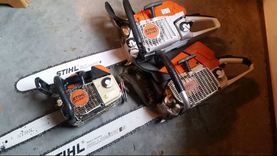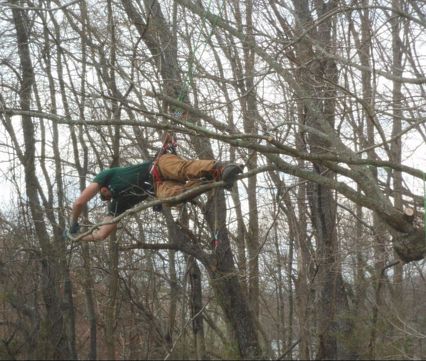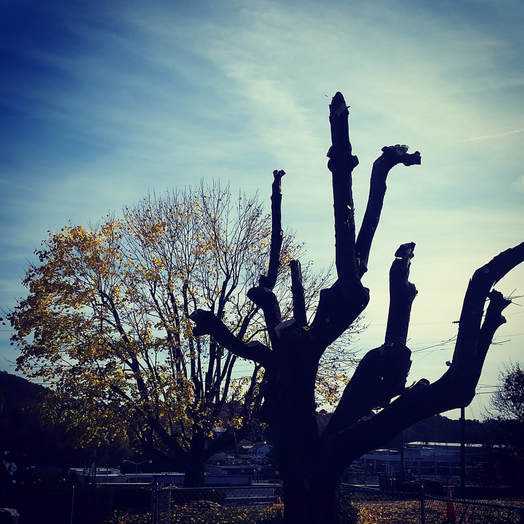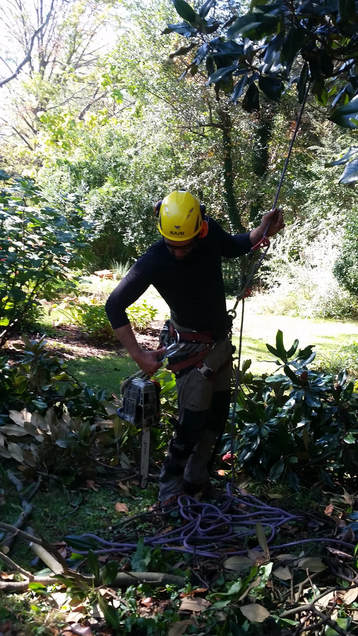|
The best time to mulch a tree is:10 Years Ago. The second best time is:Right Now!
In order for any tree to make the transition from a maturing tree to an old tree, organic matter (mulch) must be in place, ideally it will have been in place since the tree sent out roots. The functions of mulch with respect to trees are:
So when we mulch our trees we are making a choice to align ourselves with Natural Law. The new term we are seeing is “biomimicry”. This does a good job of describing what we try to do in our yards. A ½ acre of grass is basically a desert from a biodiversity standpoint (we do have a lawn to play in at our home). For a huge organism like a White Oak planted in the yard, there is no resupply of nutrients taking place and the primary functions of the tree- Grow, Reproduce, Defend, Stabilize- will suffer. The plight of the tree is exacerbated by the use of chemical fertilizers and poison’s like herbicide. As the tree gets older, it will start to draw on its reserves more and more-eventually starting to decline much sooner than its forest dwelling brethren. A 100 year old tree in the Urban environment is becoming rare. Does this mean that we ought to be covering our entire yards with wood chips? Not necessarily (although that would be a HUGE ecological benefit to your corner of the world), but are there areas that we are mowing that we could let go wild? There always are, we simply need to reframe our perspective on what beauty is (I’m talking to the dandelion haters here). If you want to support trees that are in the middle of your yard, you can start by establishing a mulch ring a minimum of 2x the diameter of the trunk (4x diameter would be exceptional) that is 8-10” thick upon first application. Keep in mind that the mulch is going to degrade to about 2-4” thick within a calendar year and will need to be reapplied. The other 6-8” of mulch will have transformed into an ⅛” thick layer of black gold compost. Anecdotally, when the deforestation of our Eastern Woods commenced in the 1700-1800s there was reported to be 3 FEET of this composted topsoil over the now remaining red clay (subsoil). If all the dead tree parts that it took to make 3 FEET of topsoil were piled up, we would be swimming in 192 Vertical Feet of wood chips. WOW. Arborist love, Jason
0 Comments
I think my trees are healthy, but how do I know?
By the end of May, deciduous trees in the Appalachian region have completed the leafing out process. Arborist and homeowners will have noticed if a tree does not have a full canopy of leaf material. Interior deadwood on hardwood and softwood trees is a normal function of the tree getting larger and less sunlight making its way into the inner canopy. While this deadwood can and should be pruned out for crown health and safety reasons, it does not indicate that a specimen is going into decline. Dead branches in the outer third of the canopy that are otherwise not being blocked from sunlight can be a symptom of a tree going into decline. This process is called trenching and happens when trees move into old age, and do not have the resources under ground to maintain the canopy at the furthest extent. The tree pulls back its energy reserves to lower areas and abandons the outer canopy. If caught early this process can sometimes be forestalled or even reversed. Perhaps avoiding a costly removal and loss of a tree that may have taken generations to grow. Arborist love, Jason Watering the Trees
How do I know if my trees need water? At the time of this writing, rainfall totals in the area are close to half the average. The growing season was met with no rain in May or June, a wet July and a very dry August. The perennial plants are starting to wilt in order to conserve water, but the trees have not yet shown signs of water stress. Mature broadleaf trees have the ability to transpire hundreds of gallons of water every day. At what point do we need to start thinking about watering the trees in our yard? Before we answer that question there are other questions that need to be asked: 1. How long has the tree been in the ground? If it is newly planted this year or last year, it will need additional water added to its roots while it is getting established.
Now, we can start to think about whether it would be wise to add more water to the results of our trees. In general mature trees, especially those that are supported with a wide ring of mulch, will not need to be watered during the growing season. Trees have adapted to go for a long period of time without regular watering and while it can be stressful to their systems, it is best to let them build resilience by going dry at times. Severe droughts will slow down or halt the life processes of any plant or animal and trees are no exception. When the water in the soil has been completely exhausted, the roots can start to desiccate (die) and there will be a subsequent die back in the crown due to the lack of support system. If we have decided that the stress is great enough to intervene and add water there are more considerations and best practices. Long irregular waterings are preferable to small regular amounts of water on the roots. The reason for this is that the tree roots extend out approximately 4x the diameter of the trunk or farther and reach down about 18 inches into the soil. It takes quite a bit of water over a long period of time to soak the entire root zone of a mature tree . If we were to water a tree every day with a little bit of water, the roots will adjust and grow in the upper inches of the soil exposing them to extremes temperature, and to desiccation if and when we stop watering. So watering your trees long, low and slow is ideal. In fact the best time to water is right after a rainfall that has followed a drought. If you have some trees or new plants that you think could use a drink, the perfect time to water is after or during that rain. The quality of the water used is something that I never thought much about until recently. If you live in an area with tap water, the water is treated with chemicals and chlorine to make it “safe for drinking”. The chlorine and chemicals in the water kill organic life. The tree roots have evolved to grow in symbiotic relationship with mycorrhizal fungi, which cannot survive in chlorinated environment. The best water to use is rainwater. If that is not available tap water can be dechlorinated if it sits in a bucket or pail for at least 24 hours. This could be challenging for large scale watering unless you have a 250 Gallon bucket in your garage. Sunlight and the oxidation process will remove the chlorine and make it much safer for the biosphere. Final Thought: Hardly any tree in an urban landscape has enough mulch from the viewpoint of “how it evolved to grow” -large, sturdy, old. If you haven't, consider putting in a mulch bed preferably of arborist chips. These will support the tree through drought and extremes in temperature. They will allow exponentially more water to get down into the soil as opposed to grass which sheds the water off like green pavement. More on mulch next time… Arborist Love, Jason LaRose Jason LaRose |
AuthorJason and Danielle LaRose Archives
April 2024
|




 RSS Feed
RSS Feed